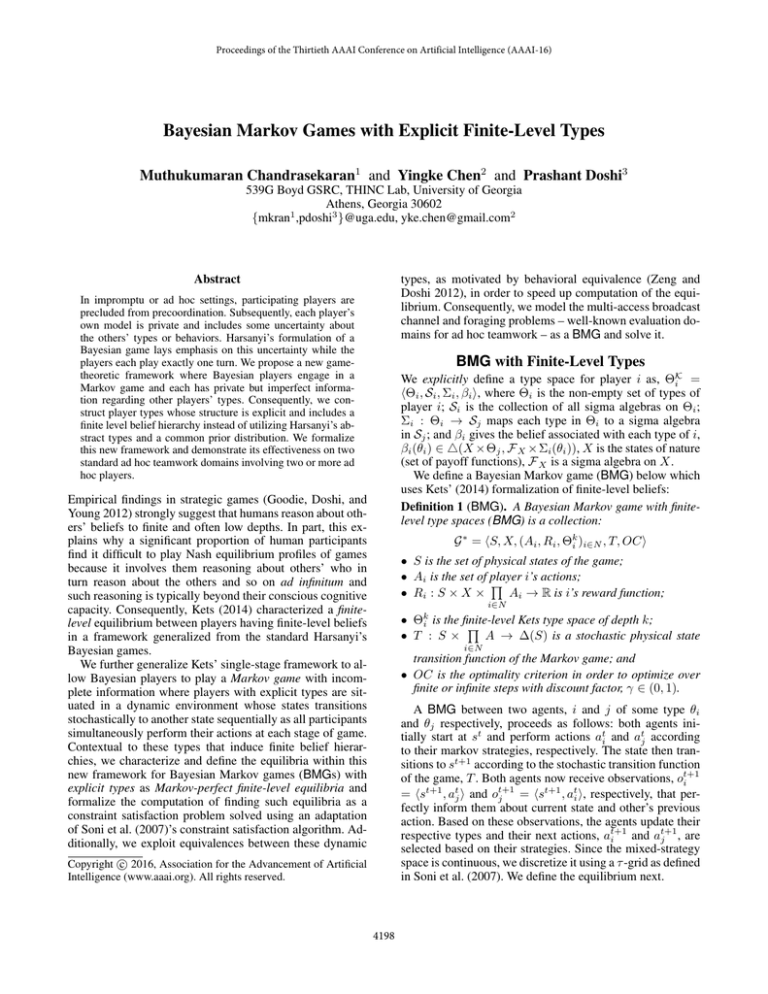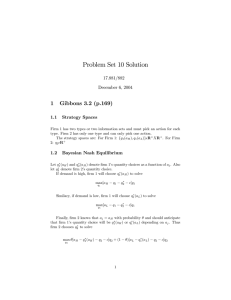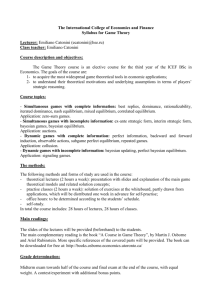
Proceedings of the Thirtieth AAAI Conference on Artificial Intelligence (AAAI-16)
Bayesian Markov Games with Explicit Finite-Level Types
Muthukumaran Chandrasekaran1 and Yingke Chen2 and Prashant Doshi3
539G Boyd GSRC, THINC Lab, University of Georgia
Athens, Georgia 30602
{mkran1 ,pdoshi3 }@uga.edu, yke.chen@gmail.com2
types, as motivated by behavioral equivalence (Zeng and
Doshi 2012), in order to speed up computation of the equilibrium. Consequently, we model the multi-access broadcast
channel and foraging problems – well-known evaluation domains for ad hoc teamwork – as a BMG and solve it.
Abstract
In impromptu or ad hoc settings, participating players are
precluded from precoordination. Subsequently, each player’s
own model is private and includes some uncertainty about
the others’ types or behaviors. Harsanyi’s formulation of a
Bayesian game lays emphasis on this uncertainty while the
players each play exactly one turn. We propose a new gametheoretic framework where Bayesian players engage in a
Markov game and each has private but imperfect information regarding other players’ types. Consequently, we construct player types whose structure is explicit and includes a
finite level belief hierarchy instead of utilizing Harsanyi’s abstract types and a common prior distribution. We formalize
this new framework and demonstrate its effectiveness on two
standard ad hoc teamwork domains involving two or more ad
hoc players.
BMG with Finite-Level Types
We explicitly define a type space for player i as, ΘK
i =
Θi , Si , Σi , βi , where Θi is the non-empty set of types of
player i; Si is the collection of all sigma algebras on Θi ;
Σi : Θi → Sj maps each type in Θi to a sigma algebra
in Sj ; and βi gives the belief associated with each type of i,
βi (θi ) ∈ (X ×Θj , F X ×Σi (θi )), X is the states of nature
(set of payoff functions), F X is a sigma algebra on X.
We define a Bayesian Markov game (BMG) below which
uses Kets’ (2014) formalization of finite-level beliefs:
Definition 1 (BMG). A Bayesian Markov game with finitelevel type spaces (BMG) is a collection:
Empirical findings in strategic games (Goodie, Doshi, and
Young 2012) strongly suggest that humans reason about others’ beliefs to finite and often low depths. In part, this explains why a significant proportion of human participants
find it difficult to play Nash equilibrium profiles of games
because it involves them reasoning about others’ who in
turn reason about the others and so on ad infinitum and
such reasoning is typically beyond their conscious cognitive
capacity. Consequently, Kets (2014) characterized a finitelevel equilibrium between players having finite-level beliefs
in a framework generalized from the standard Harsanyi’s
Bayesian games.
We further generalize Kets’ single-stage framework to allow Bayesian players to play a Markov game with incomplete information where players with explicit types are situated in a dynamic environment whose states transitions
stochastically to another state sequentially as all participants
simultaneously perform their actions at each stage of game.
Contextual to these types that induce finite belief hierarchies, we characterize and define the equilibria within this
new framework for Bayesian Markov games (BMGs) with
explicit types as Markov-perfect finite-level equilibria and
formalize the computation of finding such equilibria as a
constraint satisfaction problem solved using an adaptation
of Soni et al. (2007)’s constraint satisfaction algorithm. Additionally, we exploit equivalences between these dynamic
G ∗ = S, X, (Ai , Ri , Θki )i∈N , T, OC
• S is the set of physical states of the game;
• Ai is the set of player i’s actions;
• Ri : S × X ×
Ai → R is i’s reward function;
i∈N
• Θki is the finite-level Kets type space of depth k;
• T : S×
A → Δ(S) is a stochastic physical state
i∈N
transition function of the Markov game; and
• OC is the optimality criterion in order to optimize over
finite or infinite steps with discount factor, γ ∈ (0, 1).
A BMG between two agents, i and j of some type θi
and θj respectively, proceeds as follows: both agents initially start at st and perform actions ati and atj according
to their markov strategies, respectively. The state then transitions to st+1 according to the stochastic transition function
of the game, T . Both agents now receive observations, ot+1
i
= st+1 , atj and ot+1
= st+1 , ati , respectively, that perj
fectly inform them about current state and other’s previous
action. Based on these observations, the agents update their
and at+1
respective types and their next actions, at+1
i
j , are
selected based on their strategies. Since the mixed-strategy
space is continuous, we discretize it using a τ -grid as defined
in Soni et al. (2007). We define the equilibrium next.
c 2016, Association for the Advancement of Artificial
Copyright Intelligence (www.aaai.org). All rights reserved.
4198
|N| = 2
|N| = 3
Definition 2 (Markov-perfect finite level equilibrium). A
h
profile of strategies, πkh = πi,k
i∈N is in Markov-perfect
finite-level equilibrium (MPFLE) of level k if the following
holds:
Run Time (s)
4
1. Each player has a Kets type space of level k;
h
, j ∈ N , j = i and at every horizon is com2. Strategy πj,k
prehensible for every type of player i.
3. Each player’s strategy for every type is a best response to
all other players’ strategies in the profile and the equilibrium is subgame perfect.
10
103
2
10
1
10
0
10
-1
10
-2
10
0.25
0
0.5
0.333
0.75
Run Time (s)
10
Notice that if, instead of condition 1 above, players possess the standard Harsanyi type space, then Def. 2 gives the
Markov-perfect Bayes-Nash equilibrium. However, a profile
of strategies in equilibrium may not lie on the τ -grid. Therefore, the discretization may introduce error and motivates relaxing the exact equilibrium to -MPFLE which relaxes the
strict requirement of the exact equilibrium allowing a player
in approximate equilibrium to deviate if her loss due to deviating to some other strategy is not more than . Interestingly,
an upper bound on may be obtained for a given value of τ .
Finally, a MPFLE may not always exist for a BMG of level k
because the given Kets type space of a player may not admit
any comprehensible and best response strategy as required
by conditions 2 and 3 of Def. 2.
10
6
5
4
5
ε = 0.2
ε = 0.1
ε = 0 (exact)
Run Time (s)
10
103
102
101
100
10-1
2
3
5
10
4
10
3
10
2
10
1
10
100
10-1
10-2
10-3
Horizon (H)
H
5
ε
0.5
1
τ
0.2
τ=1
τ = 0.5
1
2
3
Horizon (H)
Without TE
|Θk=1 | Time (s)
16
1.56
36
31.24
64
>1 day
With TE
|Θk=1 | Time (s)
4
1.26
16
26.7
25
3161.7
Table 1: Computational savings due to TE while computing a
pure-strategy MPFLE in 2MABC for Kets level 1 type spaces.
Experimental Results
framework also offers a promising departure point for modeling empirical data on strategic interactions betwen humans. This further motivates its study and forms an important avenue of future work.
We implemented the MAC3 constraint satisfaction algorithm for obtaining MPFLE and show the applicability of
BMGs toward two benchmark domains used in the ad hoc
team work literature: n-agent multiple access broadcast
channel (nMABC) and level-based foraging (m × m Foraging) .
We begin by noting that the pareto-optimal MPFLE generated by our CSP coincides with the optimal joint policy
obtained from a decentralized POMDP using DP-JESP (Nair
et al. 2003) for the 2MABC problem. This empirically verifies the correctness of our approach. Multiple equilibria with
pure and mixed comprehensible strategies were found for
level 1 Kets type spaces. Next, in Fig. ?? we explore the runtime performance of BMG and investigate how varying the
different parameters impacts the performance and scalability in the two domains. Next, we systematically and exactly
compress large type spaces using exact behavioral equivalence. This type equivalence (TE) preserves the quality of the
solutions obtained, which we verified empirically as well.
Table 1 illustrates the reduction in type space due to TE in
2MABC for H = 5 and the computational savings in generating one pure-strategy profile in equilibrium.
References
Goodie, A. S.; Doshi, P.; and Young, D. L. 2012. Levels of
theory-of-mind reasoning in competitive games. Journal of
Behavioral Decision Making 24:95–108.
Kets, W. 2014. Finite depth of reasoning and equilibrium
play in games with incomplete information. Technical Report 1569, Northwestern University, Center for Mathematical Studies in Economics and Management Science.
Singh, S.; Soni, V.; and Wellman, M. 2004. Computing
approximate bayes-nash equilibria in tree-games of incomplete information. In 5th ACM Conference on Electronic
Commerce, 81–90.
Soni, V.; Singh, S.; and Wellman, M. P. 2007. Constraint
satisfaction algorithms for graphical games. In Joint Conference on Autonomous Agents and Multi-Agent Systems (AAMAS), 423–430.
Zeng, Y., and Doshi, P. 2012. Exploiting model equivalences
for solving interactive dynamic influence diagrams. Journal
of Artificial Intelligence Research 43:211–255.
Conclusion
To the best of our knowledge, BMG is the first formalization of incomplete-information Markov games played by
Bayesian players, which integrates types that induce finitelevel beliefs into an operational framework. In particular,
BMGs are better suited for modeling ad hoc coordination
in comparison to previous game-theoretic frameworks. The
4199









